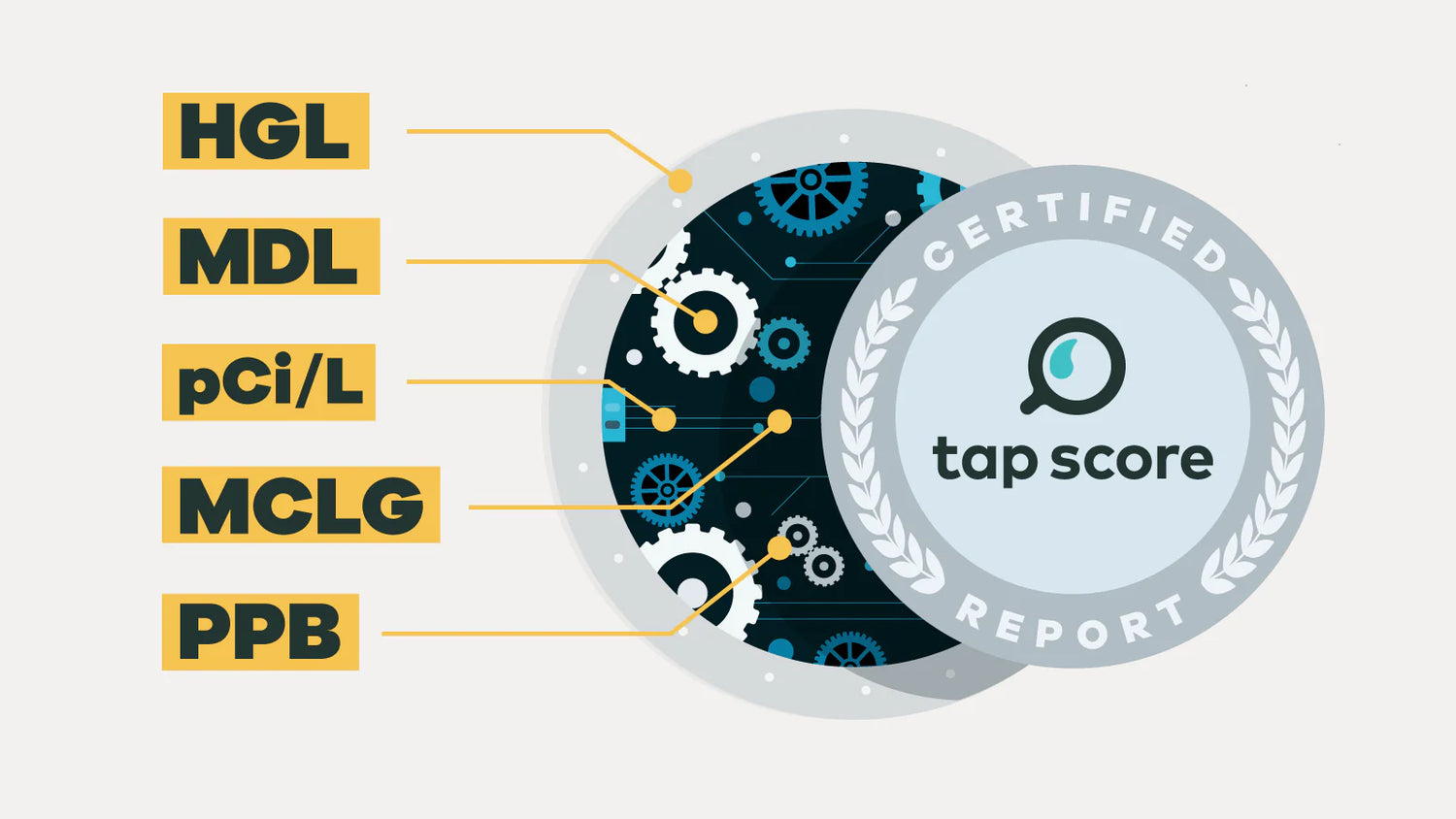
Common Tap Score Report Terms: What Do They Mean?
Our blog is written by real experts— not AI. Each guide is carefully reviewed and updated based on the latest research. Plus, with no affiliate links, you can count on unbiased insights you can trust.
The environment, the infrastructure, and the plumbing of your home can all have major effects on the water you drink, cook with, and bathe in. Subsequently, understanding water quality can be far from simple.
Because water quality is indispensable to healthy living, making sense of our tap water is vital to our well-being. This is where your Tap Score report comes into play. Our proprietary Tap Score reports make it easy to understand exactly what’s in your water and what you can do about it. Take a look at an example Tap Score report.
Below is a breakdown of common terms, acronyms, and concepts that you’re likely to encounter on your report.
Watch: How Tap Score Calculates Your Water Quality Score
Read on to understand what they mean.
Benchmarks
Your Tap Score report will include an array of “benchmarks” against which you can compare your report’s results.
A benchmark is a threshold of acceptability for each parameter tested. In a particular water sample, benchmarks help us determine whether a parameter is too high or too low. Benchmarks for a parameter can be specific to the parameter’s health, aesthetic, or pipe impacts.
Benchmarks allow us to standardize lab results that may vary widely in terms of their values and units. The benchmarks used in the Tap Score algorithm are gathered from expert sources and authoritative agencies. Read more about the Tap Score algorithm here: How Does the Tap Score Algorithm Work?
As you toggle between the various benchmark options, your Tap Score report will reflect how your result compares against the given assessment. Below are definitions of the most common benchmarks against which water quality can be measured.
HGL
The Health Guidance Level (HGL) is a health protective drinking water benchmark compiled by SimpleLab to help make lab results easier to interpret.
The HGL is determined by selecting the lowest, and therefore, most protective human health benchmark available from public health agencies for a contaminant.
It represents the concentration above which there may be a potential risk to human health if the water is consumed over a lifetime.
Some of the benchmarks that the HGL is derived from include Federal Maximum Contaminant Level Goals (MCLG) and California's Public Health Goals (PHG). Drinking water at or near the HGL over the course of your lifetime is thought to be safe and protective of your health.
Federal MCL
The federal maximum contaminant level (MCL) is an enforceable primary drinking water standard set by the U.S. EPA. MCLs are the highest concentration of a contaminant permitted in drinking water from public water systems under the Safe Water Drinking Act.[1] MCLs are set as close as possible to health protective levels, while also taking into account the cost and availability of treatment technologies.
Federal MCLG
The federal level maximum contaminant level goal (MCLG) is a non-enforceable public health objective. MCLGs are set to zero for known carcinogens, or a lifetime no-effects level for non-cancer endpoints, assuming that you drink the tap water for 70 years. This is considered a minimum risk level that is protective of your health.
Laboratory Parameters
All laboratory testing instruments and methods have an inherent minimum detection level–a concentration below which an instrument fails to measure something reliably. If you’re doing a laboratory water test then you want to know how low of a concentration your laboratory’s instruments can “see”. For a more in-depth review of laboratory detection and reporting limits, take a look at this guide here: Laboratory Detection Limits Explained. Below are definitions of two of most frequently cited terms below:
MDL
The method detection limit (MDL) is the lowest value at which a laboratory is confident it can detect a contaminant.
LOQ
The limit of quantification (LOQ), or the reporting limit (RL) is the concentration at which the laboratory is confident enough to accurately quantify the concentration of a detected contaminant.
Units
Water contaminants are measured using a variety of units depending on what fits best. Some units can readily convert between one another (like PPM, PPB, and PPT), others are entirely unrelated. For an in-depth summary of common water report units, take a look at this guide: How To Interpret Water Testing Units. We’ve defined some of the most common units below.
PPM
The parts per million (PPM) notation is used to convey a ratio of mass to volume of a concentration in water. It stands for one part of contaminant by mass to one million parts water by volume. Based on the density of water, we know that 1 PPM is equivalent to a mass-to-volume ratio of 1 mg/L. Therefore if you have 10 PPM of nitrate in your water, you have 10 mg/L of nitrate in your water.
PPB
The parts per billion (PPB) notation is used to convey a ratio of mass to volume of a concentration in water. It stands for one part of contaminant by mass to one billion parts water by volume. Based on the density of water, we know that 1 PPB is equivalent to a mass-to-volume ratio of 1 ug/L. Therefore if you have 10 PPB of nitrate in your water, you have 10 ug/L of nitrate in your water.
PPT
The parts per trillion (PPT) notation is used to convey a ratio of mass to volume of a concentration in water. It stands for one part of contaminant by mass to one trillion parts water by volume. Based on the density of water, we know that 1 PPT is equivalent to a mass-to-volume ratio of 1 ng/L. Therefore if you have 10 PPT of nitrate in your water, you have 10 ng/L of nitrate in your water.
PPQ
The parts per quadrillion (PPQ) notation is used to convey a ratio of mass to volume of a concentration in water. It stands for one part of contaminant by mass to one quadrillion parts water by volume. Based on the density of water, we know that 1 PPQ is equivalent to a mass-to-volume ratio of 1 pg/L. Therefore if you have 10 PPQ of nitrate in your water, you have 10 pg/L of nitrate in your water.
pCi/L
Radiological compounds are frequently measured as the ratio of radioactive decay per unit volume. Picocuries per liter (pCi/L) is a standard unit. A picocurie (pCi) is the rate of radioactive decay of a radioactive element. One pCi is one trillionth of a Curie, or 0.037 disintegrations per second.
CFU/mL
Bacterias grow in colonies. As such, a common measure of bacteria in drinking water is to measure the number of colony forming units (CFU) per milliliter (mL) of water. CFU/mL therefore measures the concentration of viable bacterial (or fungal) cells in water.
Present/Absent
Present/Absent is a binary way of reporting the presence or absence of bacteria, fungi, or any contaminant that does not get quantified at the lab. If a contaminant is “present”, it has been detected in water, but not quantified. If a contaminant is “absent”, it was not detected in water.
Non-detect
Non-detect is short for non-detection, or not detected. This phrase is used to indicate that the laboratory tested for a contaminant, but it was not detected above the detection limit. A non-detect does not mean that the contaminant concentration is zero–but rather that, given laboratory methods and analytical instrument capacities, the contaminant was not seen above a very low concentration (the detection limit).
Questions About Tap Score?
Tap Score combines world-class laboratory science with customer service to ensure testing your drinking water is simple, fast and factual. Everything we do is driven by data and supported by a team of experts ready to answer your questions. Contact the Tap Score team today!










